Last week I sent an e-mail out to a couple hundred local teachers and librarians (those in my e-mail address book), in which I told them about our store’s upcoming events (next week = Gary Paulsen!) and extolled the virtues of more than a few forthcoming books I thought might be of interest to them. Looking over the message later, it occurred to me that these recommendations might also be of interest to some of you as well, so I’ve pasted the text of the message below. I hope you’ll share your favorite recent discoveries (for any age!) in the comments field at the end.
****
I’ve been reading and loving so many things of late, it’s hard to know where to start! Here’s a quick introduction to a few of my new favorites.
The hottest title on our shelves this week is The Wimpy Kid Movie Diary by Jeff Kinney (Abrams, available now, $14.95). Lest you dismiss it as just a big movie studio’s way to make more money, let me tell you that this is not just marketing fluff. This is a really, really, REALLY cool book that explains, in great detail, how the Diary of a Wimpy Kid movie was made. Even kids who aren’t Wimpy Kid fans (are there any?) will enjoy reading this book, because it will tell them everything they’ve ever wanted to know about what happens on a movie set, how casting works, what costume makers think about, how much time is spent filming each day, how a script is written, how film is edited, and so on and so on and so on. This is a great non-fiction pick for reluctant readers!
Did you read The Squirrel’s Birthday and Other Parties by Toon Tellegen (Sterling, available now, $12.95) — one of my favorite all ages read-alouds of 2009? If so (or if not!) you’ll want to be sure to pick up a copy of Letters to Anyone and Everyone (Sterling, available now, $12.95), which features correspondences in letter form between the same charming woodland creatures as appeared in the first book. (Note that you can read these books in any order!) There are reportedly many more of these Toon Tellegen gems being imported from the Netherlands, which makes me more than a little bit happy. I can’t wait to read the next one!
Looking ahead a bit… Pam Munoz Ryan has a terrific new novel coming in April (Scholastic, $16.99) – it’s a fictionalized biography of poet Pablo Neruda called The Dreamer, and it is lush and lyrical and just. plain. great. Printed in green ink (what Neruda called the color of hope) with illustrations by Peter Sis, it is a must read for grades 4-8. I would not be surprised to see this book on a few big awards lists come next year. (I certainly think it deserves a place there!)
Another famous historical figure appears on the pages of A Nest for Celeste by Henry Cole (HarperCollins/Katherine Tegen Books, available now, $16.99). This clever tale is narrated by a mouse who befriends the teenage assistant of John James Audubon while the two are collecting avian specimens in Louisiana. Lively pencil illustrations fill the pages of this novel and do much to enhance the story of a mouse with understandable doubts about Audubon’s practice of shooting birds in order to paint them. While topic of guns may not play well in all elementary school classrooms, I think this book is probably best appreciated by kids in grades 3-5.
Sarah Weeks fans will not be disappointed with her forthcoming novel As Simple as It Seems (HarperCollins, coming in June, $15.99), which stars two very memorable, very likable characters, each facing genetic hurdles that are all too common but not often seen in middle grade novels. One was born with fetal alcohol syndrome, the other is allergic to everything under the sun (yes, peanuts included).
Be prepared to fall in love (again) with Deborah Wiles’s wonderful ability to bring life to the page. Her new novel Countdown (Scholastic, $16.99, coming in May) is fresh, funny, and chock full o’ fuel for discussion. As if that’s not enough, it’s the first in a trilogy of books set in the 1960s that’s replete with visual artifacts from the time (newspaper photos, advertisements, media quotes, pop culture images) and the first in a trilogy, meaning we’ll get to spend time with these characters for longer than just the length of this one volume. This book is probably best suited to grades 4-8.
I think it would work be interesting to pair Countdown with Rosemary Wells and Dino Fernandez’s forthcoming My Havana: Memories of a Cuban Boyhood, illustrated by Peter Ferguson $17.99 (Candlewick Press, coming in August, $17.99, probably best suited to grades 2-5). One of the topics in Fallout is the Bay of Pigs invasion, and with that comes some discussion of life in Cuba under Fidel Castro. My Havana is about Fernandez’s childhood in the 1950s, in pre-Castro days, but it sets the stage perfectly for what will follow in the 1960s, where the story is picked up in Fallout. This book ties nicely also to immigration units and studies of architecture!
Middle school and high school teachers will want to get their hands on Sources of Light by Margaret McMullan ($16, available now, probably best for grades 6-10). Ever since I read her first novel, How I Found the Strong, I’ve been waiting for the world to wake up and discover her near-perfect prose. McMullan’s new novel about a girl discovering the art of photography and the nuanced emotions on both sides of the struggle for Civil Rights could (and ought to be) the book that finally makes that happen. I read this book in one sitting, and I know it’s going to stay with me (for which I’m grateful).
Another winner for mature readers is Finnikin of the Rock by Melina Marchetta (Candlewick Press, available now, $18.99). I fell madly in love with the cast of this deeply emotional fantasy when Melina herself sent me a copy almost a year and a half ago. I meant to blog about it then. And I meant to blog about it a month later. And I meant to blog about it soon after that. And now… Well, now the book is available here, and the word is out, and I am very late telling the world that this is a magical, memorable story that will not soon leave you. If you like your protagonists (both male and female) smart and strong, and you like your romance heart-stopping, this is the book for you.
As for new picture book favorites? Where to start?!
Last year at our event with Kevin Henkes, he gave us a sneak peek at his new picture book, My Garden (Greenwillow, available now, $17.99, all ages), and we all wished we could get our hands on our own copies right away! FINALLY that’s possible, and oh it was just so worth the wait! Once again Henkes proves beyond adept at capturing a child’s sensibilities and transferring them to the page. The imaginative garden that blooms on these pages will sow the seeds of creativity in any child who hears it.
While we’re on the topic of read-alouds, one of my new favorite new ones has to be Hip & Hop, Don’t Stop! by Jef Czekaj (Disney Hyperion, available now, $16.99, probably best appreciated by grades 1-5). A tortoise and the hare for the hip-hop generation, it’s clever, it’s hip, it’s funny, and your students will both laugh uproariously and award you double points for coolness when you share it with them.
Also great for riotous reading fun: Shark Vs. Train by Chris Barton ($16.99, coming in May, ages 2 – 102). Shark and Train compete at tasks as ridiculous (and outrageously funny!) as pie-eating and lemonade-selling. This is the book I’m giving to all the preschool through first grade boys in my life this year, and I’m confident that they will L-O-V-E it.
On the opposite end of the spectrum – the quiet end – is a lovely, lovely new book called The Quiet Book, written by Deborah Underwood and illustrated by Renata Liwska (Houghton Mifflin, available now, $12.95, all ages). Liwska’s soft, beautiful illustrations depict different animals experiencing various kinds of quiet (first one awake quiet, making a wish quiet, and so on). Kids will enjoy thinking about the other kinds of quiet they know too. It seems almost impossible not to sigh or coo when you read this one!
The poetry book you MUST have this season? Mirror Mirror: A Book of Reversible Verse by Marilyn Singer, illustrated by Josée Masse (Dutton, available now, $16.99, grades 2-12). Marilyn Singer – the genius Marilyn Singer – has created a new form of poetry here, and the results are sparkling! Surprising! Read the poem on the left. Read the poem on the right. One is a “flipped” version of the other. (The last line of the left poem is the first line of the right poem, and so on.) Sometimes by inverting the poem, the narrator changes or the perspective shifts. Each time a familiar fairy tale or character is presented anew. You will marvel at the idea that anyone was capable of pulling off this trick!
More poetry greatness = Ubiquitous: Celebrating Nature’s Survivors by Joyce Sidman, illustrated by Beckie Prange (Houghton Mifflin, available now, $17, grades 2-8), The same dazzling duo created the Caldecott Honor-winning Song of the Waterboatman and Other Pond Poems, and Joyce Sidman is the author of this year’s Caldecott Honor book Red Sings from Treetops and This Is Just to Say: Poems of Apology and Forgiveness, which is one of our favorites. The ingenious endpapers alone make Ubiquitous a book worth owning!
My graduation gift pick: So Many Days by Alison McGhee, illustrated by Taeeun Yoo (Atheneum, available now, $15.99, all ages). Understated. Perfect. Not at all saccharine.
My pick for “Book on a Topic You *THINK* Will Be Boring But You Are In For a Surprise”: For Good Measure: The Ways We Say How Much, How Far, How Heavy, How Big, How Old by Ken Robbins (Roaring Brook Press, $17.99, available now, for all ages judging from the fact that my husband and I both read all 48 pages and found it fascinating.) Who knew the topic of measurement could be this interesting? I love the way history, social studies, math, and English lessons intersect here! More fun non-fiction with an unusual theme: Pop! The Invention of Bubble Gum by Megan McCarthy (Simon & Schuster/Paula Wiseman Books, coming in May, $15.99).
My pick for fantasy fans and language lovers: A Dignity of Dragons: Collective Nouns for Magical Beasts by Jacqueline K. Ogburn and illustrated by Nicoletta Ceccoli (Houghton Mifflin, $17, coming in May). A flurry of yeti. A splash of mermaids. A riddle of sphinx. What could be more clever?
Earth Day Must-Haves: Here Comes the Garbage Barge by Jonah Winter, illustrated by Red Nose Studio (Random House/Schwartz & Wade, available now, $17.99, grades 1-8); Poetrees by Douglas Florian (Simon & Schuster/Beach Lane Books, available now, $16.99, grades 1-8); and We Planted a Tree by Diane Muldrow, illustrated by Bob Staake (Golden Books, available now, $17.99, preK-3rd grade). Here Comes the Garbage Barge is non-fiction of the lively, memorable sort and WOW are the illustrations in this book cool! (Flip the dust jacket over to see how they were done, AND watch the uber-cool video on YouTube.) I have already heard reports of this being a great read-aloud with 5th graders. Poetrees is a grand-slam of a poetry book from the wildly witty Florian about what? Trees. Obviously. Again — a great read-aloud. Finally, We Planted a Tree is a great book about the positive impact that planting trees has on the lives of people all over the world. A complex topic is presented simply and clearly here, with bold, cheerful illustrations. Terrific!
A Great Mother’s Day Read: Little Rabbit and the Meanest Mother on Earth by Kate Klise and M. Sarah Klise (Harcourt, available now, $17). Over the top fun, with a big top twist!
A Great Father’s Day Gift: The Extraordinary Mark Twain (According to Susy) by Barbara Kerley, illustrated by Edwin Fotheringham (Scholastic, available now, $17.99, grades 2-8). A biography of Mark Twain and his daughter Suzy who wrote her own biography of her dad when she was just 14 years-old. Clever, funny, touching, and a great homage to the bond between father and child.
My New Favorite Beach-Themed Read: A Beach Tail by Karen Lynn Williams, illustrated by Floyd Cooper (Boyds Mills Press, available now, $17.95). I love the simplicity of this story and the fact that it’s so kid-centered. Dad takes Gregory to the beach, where Gregory draws a lion in the sand. “Don’t go in the water, and don’t leave Sandy,” says Dad. Dad snoozes under an umbrella, as Gregory draws Sandy’s tail — a tail that gets longer and longer and longer as Gregory absentmindedly draws his way down the beach and away from Dad. When he finally realizes that Dad is no longer in sight, Gregory follows Sandy’s tail and finds his way back. This is a light, fun story, illustrated with sandy looking artwork rendered perfectly by Floyd Cooper. Young readers will love the building suspense as Gregory strays further and further from familiar ground, and they’ll revel (secretly) in the joy of being able to stray where they want to, while still being tethered to home.
And this is just the tip of the iceberg! There are many, many more gems arriving now and coming in the next few months, including my husband‘s graphic novel of The Odyssey, coming from Candlewick Press in October! (Yes, I’m biased, but I think when you see it you’ll be really, really pleased.) So far 2010 is looking to be yet another great year for books!
****
Okay, ShelfTalker readers, now it’s YOUR turn! What new (and/or forthcoming) books are you excited about? Please share your recent discoveries here!
Monthly Archives: March 2010
Filling Their Baskets with Books
Josie Leavitt - March 30, 2010
It’s not just children who love the Easter Bunny.  As a bookseller, I’ve come to love the retail pop we get from this springtime holiday. The Easter holiday lends itself to bright displays of colorful books. After a long winter, an Easter that falls early in spring is just the lift we all needed. Many families in our area don’t give the kids Easter candy, rather they give stacks of books. And I love them for this. Sure, kids love candy, but frankly, I think getting a basket of books is a far better idea than massive amounts of sugar first thing in the morning. Once the candy’s gone, there’s nothing left but an unpleasant sugar crash. Books last forever and they can create traditions that mean more than one more candy egg.
As a bookseller, I’ve come to love the retail pop we get from this springtime holiday. The Easter holiday lends itself to bright displays of colorful books. After a long winter, an Easter that falls early in spring is just the lift we all needed. Many families in our area don’t give the kids Easter candy, rather they give stacks of books. And I love them for this. Sure, kids love candy, but frankly, I think getting a basket of books is a far better idea than massive amounts of sugar first thing in the morning. Once the candy’s gone, there’s nothing left but an unpleasant sugar crash. Books last forever and they can create traditions that mean more than one more candy egg.
Over the weekend the store was full of parents surreptitiously hiding — in some cases, actually hurling — books at me to hide and wrap before the kids found out. Wish lists get filled out with vigor, knowing that wishes might get granted long before birthdays roll around.
Setting up Easter displays involves the usual Easter books, but we like to add an actual basket or two filled with great book suggestions for all ages. The baskets are overflowing with yummy books for all ages, books, like Understood Betsy (a classic Vermont book), D’Aulaire’s Book of Greek Myths, Mr.Popper’s Penguins, Hatchet, The Great Brain, George and Martha, oh, the list goes on. It’s just so much fun.
There’s less retail frenzy than the Christmas season, and I enjoy this pace more. Folks seem more thoughtful about selecting books and this pleases me. I find Easter is a great time for sharing childhood favorites with the children in your life.
So, hop on down to your local indie, and fill their baskets with books.
Getting to Yes (and No) Faster
Josie Leavitt - March 29, 2010
Every independent bookstore owner or manager must contend with self-published authors who want their book to be stocked by the store, and charitable groups seeking donations. There are different ways to handle these requests, and until now, I’ve always been put in the awkward position of dealing with each person right there, on the spot at the register, and that can get uncomfortable. Do I want to donate a gift card to the eighth-grade field hockey team? Do I want to carry three copies of a self-published book about a farmer in Maine?
With the help of bookselling friendships fostered at Winter Institute 5 and through NECBA, my local children’s bookselling trade association, I’ve been given great tools to help me with these two tough situations.
It sounds simple, but a good consignment form is a gift. It allows me to accept most self-published books on consignment in a very professional manner. My form (adapted from the Bookloft in Great Barrington, MA) is simple and clearly states what the terms of sale are: 40% and after six months, the book will be returned to the author. The form makes it easier for me to be organized. Often self-published authors are learning about the business, and the form saves me from having to explain, repeatedly, how the self-published author/bookstore relationship works. They get a copy for their files, and we keep a copy. Everyone is on the same page, so there can be no surprises when it’s time to reconcile accounts or send the books back.
The consignment form, with its time limit, allows me to say yes far more often than I did in the past. Also, for me, who can be filing challenged, this works really well. One universal form, one file folder for everything in chronological order — this makes my life a lot easier. And having all the author’s info in one place makes re-stocking the books a breeze. So this can be a win-win for everyone.
The donation request form (adapted from Saturn Booksellers, in Gaylord, MI) is pure genius. This form allows my staff to be pro-active with donation seekers. So, rather than just take a message, they can give them the form, or better yet, they can email the donation seeker the form. The donation request form is direct. It states very simply, that we cannot give to everyone as much as we’d like to, but we want to be fair, so please answer some questions and we’ll make a decision within two weeks.
What’s great about this form is it asks the usual questions about the organization/event: how many people are expected to attend, how is this event related to literacy, how will it be promoted, etc. Then there are the questions that all booksellers want to ask of organizations but find it hard to do when there’s someone standing at the register asking for something: how many times a month do you or staff from your organization shop at the store?
This one question makes it clear that shopping local and community support are a two-way street. I’ve emailed this form to many folks since I started using it and I’ve gotten some very different answers. Some are really honest,”No one has shopped at your store because you’re an hour away from us.” That realization had them withdraw their request. “I’ve driven by a hundred times, but will now make a effort to stop,” and they did.
Getting all the information in one tidy page has made it easier for me to make informed decisions about charitable giving. Every two weeks we look at the forms, look at our charitable giving budget, and triage what we’re able to do. Obviously, events that benefit children’s literacy within my local region get priority and then we’ll work our way down the list. The donation form allows me to be better at business and sometimes, that means saying no, and that’s never an easy thing. But the process of filling out the form can make an organization realize that we’re not a good fit for them and they should ask closer to home, as was the case above.
So, don’t despair if your local bookstore asks you to fill out either a consignment or donation request form: it’s actually a great way to yes.
The Passing of Mr. Mysterious
Elizabeth Bluemle - March 26, 2010
For anyone younger than 55, Sid Fleischman is an icon, his books part of the canon of the finest in American children’s storytelling. His marvelous stories are notable for their immense child appeal and signature combination of high adventure, mischievous tall-tale-telling, and loads of humor — all written without a single unnecessary word. What’s not to love?!
Sid Fleischman’s very name conjures up magicians, pirates, ghosts, mysteries, journeys, bandits, kidnappings, treasures, horses, mistaken identity, long-lost relatives, sudden fortunes. I remember reading Mr. Mysterious & Company when I was around eight years old. I was immediately charmed; my father, like Mr. Fleischman and his traveling show maestro, was a magician by hobby, so I felt a special connection to the young apprentice. From then on, I eagerly read every new chapter book he wrote. I loved the vivid characters and towns and countrysides and rivers and situations he created. Kids were always on the move in his books, independent and resourceful even when they were lost or outnumbered. Rascals and scalawags abounded, but they were often more ridiculous than villainous, or at least got very satisfying just deserts. There was a lightness of spirit, a joi d’esprit, about his writing that is sometimes missing from adventure stories written today.
He was also a master of that most important of genres: the young chapter book, for ages 7-10 (including and especially boys). His books are ones that make me wish for a new approach to backlist promotion; they are a hit with all the kids who can find them, but, like many older series, without a new-book promotion budget, they can be overlooked or forgotten and drift out of print. That’s already happened to a couple of my very favorites (the last three book covers pictured below), and I’m hoping that there’s some magic in the power of an entire children’s book community all thinking about his amazing literary legacy that will breathe new life into all of his titles. There are so many in print, with a few more to come; I’d like to invite all booksellers, teachers, and librarians to make a special effort to hand Sid Fleischman titles to kids and ignite a whole new generation of fans. Let’s make April Sid Fleischman month!
His was a literature of pluck and sass and resilience; he made living itself seem like a grand adventure. What a fine gift to leave to children! Mr. Sid Fleischman, we salute you.
Two links of interest:
Lisa Yee posted this on her blog: A fond farewell to a lovely friend . . . As many of you have probably already heard, Sid Fleischman has died. He was a great influence on my career. Here’s a tribute I wrote in his honor. The link also includes his obituary from the SCBWI website. http://lisayee.livejournal.com/130654.html
Finally, Garrison Keillor celebrated Sid Fleischman in his birthday portion of The Writer’s Almanac (scroll down; SF is the third birthday).
Those of you with memories to share, please feel free to share comments about this wonderful author who, by all accounts, was also a most magical friend.
























Can’t We All Get Along?
Josie Leavitt - March 25, 2010
The relationship between a store and the credit department of publishing houses is very important. Bookstores order books and it’s the credit department’s job to ensure that payments get made within terms. I’ll be honest, this has not always a been an easy relationship, but lately there seems to be a greater antagonism between publisher’s credit departments and bookstores. I can only speak anecdotally, but from my own experience and those of my colleagues the relationships seem to be deteriorating.
Many stores I have spoken with have had out-and-out battles with credit departments, some over large amounts of money, but more often than not, it’s over bills under $300. There seems to be a rush to put stores on an all-cash basis rather than maintain the net 30 terms stores usually enjoy. In the interest of fairness, I sent out a seven-question email to six of my credit reps last week and not one rep has even acknowledged receiving the email, so I can’t include their thoughts in this post. ETA: Here are the questions:
The seven questions I posed to the credit reps were:
1. Has your company had to shrink the size of its credit department over the last year in response to the economy?
2. Does your publishing company put stores on credit hold first before making them go to an all cash basis?
3. Are you finding more stores in financial difficulty than in previous years?
4. Since switching to email statements (if you have) have you found people are paying more quickly or less quickly?
5. Does part of your job include reaching out to stores and making phone calls letting them know their account is in jeopardy?
6. How many accounts is the average credit rep responsible for?
7. What’s the one thing you would like to see bookstores do to make your job easier?
I’ve spent a fair amount of time thinking about how to improve the relationship between credit departments and bookstores. Here’s my list of how I think credit departments and bookstores can work together better during these tough financial times.
– Stores should order only what they can actually pay for. Don’t sucked in by large displays or carton quantities if you might suffer buyer’s remorse when the invoice comes. Don’t think you’ll have the money in thirty days, because chances are, if you don’t have it now, you won’t have it at the end of the month.
– Credit reps might want to introduce themselves to stores before that first tense email or phone exchange about an overdue balance. If my sales reps know my name and I know theirs, we’ll actually have a relationship that extends beyond tension, and that can only be a good thing.
– Stores should make every effort to pay their bills on time, within whatever terms the various publishers have.
– Publishers should assume the best of stores that have had a good track record. Sometimes the folks who pay the bills are on vacation, sometimes life gets in the way of being timely.
– If a store finds itself in a financial bind, call your rep and let him or her know. Better to be honest right away than be forced to pay cash up front for every order.
– Publishers shouldn’t put a store on an all-cash basis without first talking to them about it before it gets out of hand. This shows a lack of trust, and to not communicate with the store and then slam them with something this big, smacks of big business trying not to deal with smaller stores. I mention this because I know several stores that have been good with their bills only to be a little late, have no communication from the credit rep and then be told they’re going to have to pay up front for the next six months or a year.
– Send in returns if you’re feeling a little strapped for cash. There’s nothing like a slow winter day to inspire me to cull my inventory and return some of the dead weight of the past year or two. Be smart about returns. Look ahead to the spring list and see who you’ve ordered the most from and return to them first.
– Stores should never have to give permission to apply account credits to any outstanding invoices. This is one of the most galling things credit departments do. I’ll get a call from a well-intentioned rep who wants to let me know that my account is a few days late and she’ll ask, “Would you like me to apply the $500 in credit you have?” Of course I do. What store says “no, please hang on to my money one more month”?
– Get your co-op done. Nothing looks nicer on a publisher statement than a bunch of co-ops to offset your bill.
– Buy smart. Take advantage of as many backlist specials as you can. Often they have better terms and dating. But don’t buy 100 units more than you need just to get a better discount or dating, because that bill is still is going to come due.
– Ask your sales rep who your credit rep and introduce yourself to him or her. There’s no reason booksellers can’t initiate a conversation and make contact before you find your account in any kind of jeopardy.
– A wise friend of mine said to pay bills every five days — that way, no bills have a chance to get too late.
– I don’t think it’s necessary to send slightly antagonistic emails every month reminding stores that their payments are in the lockbox by the 31st of the month, or they’ll be considered late and subject to a possible credit hold. Angering buyers every month when they’ve done nothing wrong is really not a good way to foster a good business relationship.
I know it’s the nature of the beast between the credit department and bookstores to be somewhat tense, but I think if we all talk to each other more frequently business will be better for both sides, and that can only benefit customers who see shelves stocked high with great books.
Bookish Birdhouses: Frances and Mary
Alison Morris - March 24, 2010
So many of you have told me that you love (and miss seeing!) the birdhouses I’ve made using picture books, so I thought I’d post a few more here every now and again, for your viewing pleasure. In all I think I’ve made close to 20 of these, almost all of them as gifts for other people. Among the few still in my possession, though, are my very first bookish birdhouse (from Book Fiesta) and this one, created using Bedtime for Frances, a book written by Russell Hoban, illustrated by Garth Williams, and very dear to my heart.
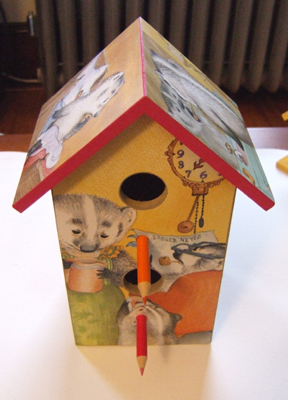
front
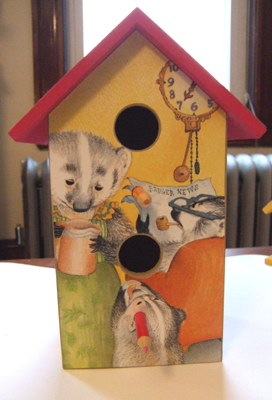
left
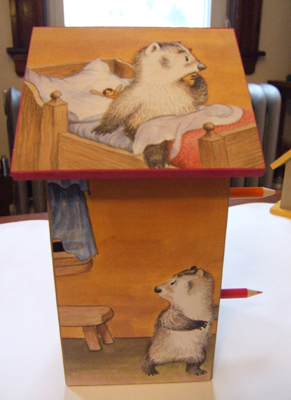
back
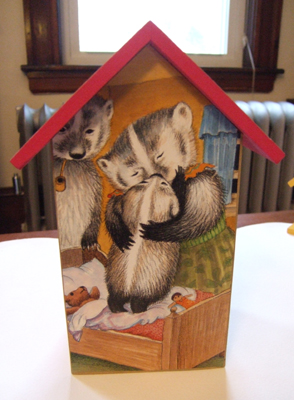
right (What you can’t see here is the crack in the ceiling that Frances is staring at, fearfully, from her place on the bed below. The crack is visible on the birdhouse, though, if you look up under the overhanging portion of the roof!)
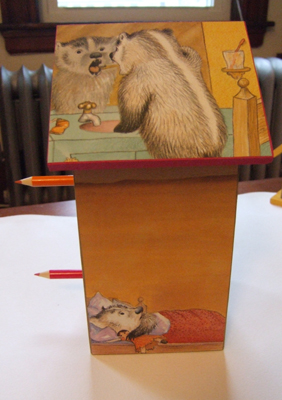
ta da! (I’m so pleased with this one.)
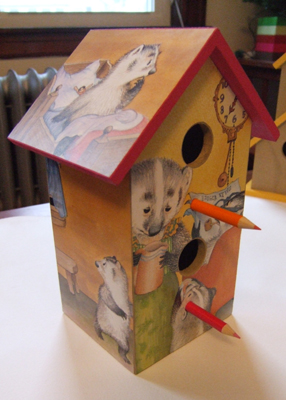
The next birdhouse, below, was in a previous life an F&G for Mary Poppins from A to Z written by P. L. Travers and illustrated by Mary Shepard. Now, it is a birdhouse in the home of Jane Kohuth, one of our wonderful children’s booksellers who is also a soon-to-be author. (Random House recently acquired 2 books by her!) Funny thing: I chose Mary Poppins because Jane is fond of classic illustrated children’s novels in this vein. It was only after I’d given it to her that she pointed out the fact that she and her husband have the same names as Mary Poppins’ charges — Jane and Michael!
front (almost)
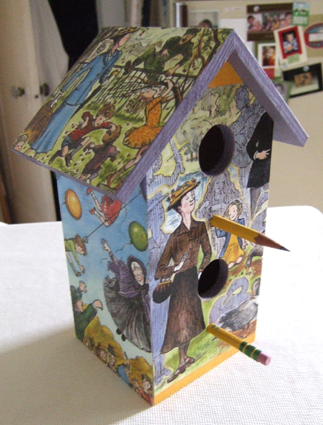
left
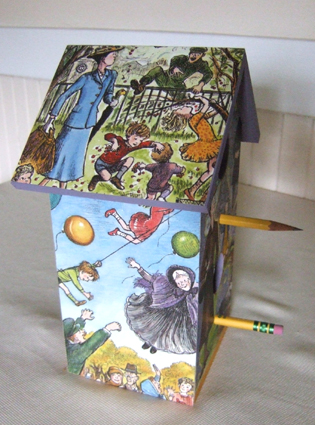
back
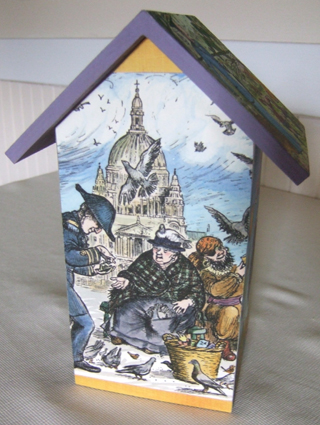
right (hmm… Mary’s face is jolly well blocked by the overhang…)
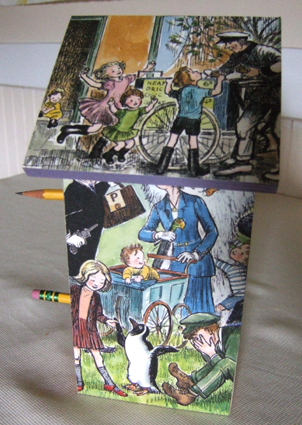
right, take 2 (AND now Mary’s face is in shadow…)
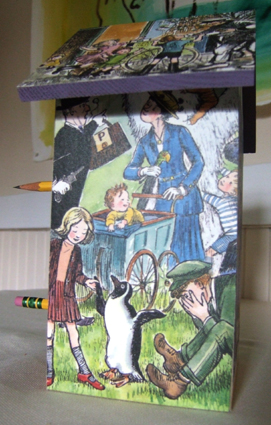
right, take 3 (AND now the whole thing is blurry, but you get the idea, right? Whew.)
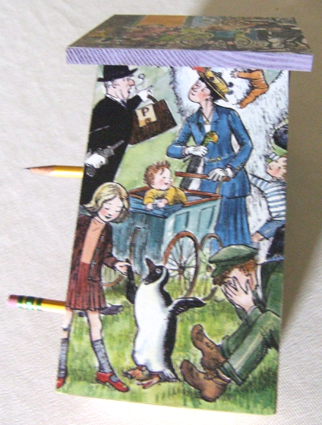
If you’re interested I’ll happily show more of these creations at a future date. I’ll also put together a how-to if any of you want more than my quick & dirty set of instructions, which are:
1. Buy cheap birdhouse.
2. Remove perches.
3. Paint it.
4. Glue pages to it.
5. Put pencils where perches where.
Done!
The End of Publishing, The Future of Publishing
Elizabeth Bluemle - March 23, 2010
This video has been making the rounds recently, and we love it. It was created by Dorling Kindersley UK for a sales conference, and everyone loved it so much that DK decided to put it on YouTube. Do watch the whole thing for the full effect. (Thanks to Kara LaReau and Erin Murphy for the link.)
Growing a Reader
Josie Leavitt - March 22, 2010
One of the absolute joys in owning a bookstore is the kids. I’m especially fond of three-and-four-year-olds who have embraced reading to such a degree that want to share their newfound love with everyone, including stuffed animals.
We have a bin of stuffies (as some kids call them now) in the picture book section that kids love to go through. Often the kids will just play with the toys, but every once in a while I see them carefully setting up the toys with books in their little stuffed laps. We have one little boy who is read to constantly by his parents and he comes in with his father about once a week or so. Young Finn is perfectly content in picture books by himself.
Someone donated three rather large dragon animals to us, and they are a favorite of Finn’s. He sets them up in the three kid-sized chairs in a circle. Then he carefully selects a book for each dragon to read. One dragon was reading a book about dragons, of course, I was told. The other two each had very different books:the red dragon had a fairy tale book and the blue dragon was reading a short truck book.
What was so revealing and lovely, was how Finn turned the pages for each dragon, retrieved fallen books and generally wanted to make sure each dragon had a satisfying and rewarding reading experience. Finn can’t read yet, but he was making up stories, mostly to the dragon reading the dragon book. I was charmed to pieces and only wish I was able to get a picture of Finn with the dragons, but he got very shy.
The care, and almost reverence, this little boy has with books was so touching. He wanted to share his love of story with anyone who would listen, and in our busy store it meant dragons. At his house, I’m sure the dog gets many books set out by his bed.
Finn’s behavior speaks to a household that loves books. He sees both parents, especially his stay at home dad, reading all the time. He is read to constantly. This simple act, sharing a story with a child, has an amazing ripple effect. These parents have grown a reader. And in turn, our stuffed animals have a reading buddy.
When Rebecca Stead Reached Us
Alison Morris - March 19, 2010
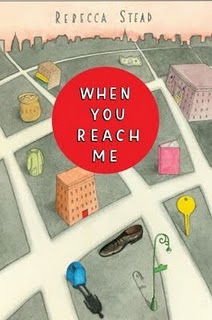
Our store had the great, great honor of playing host to Rebecca Stead for two school visits and one public event when Random House graciously sent her our way at the beginning of last month. We had been looking forward to her visit for months, but the excitement of having her here was increased exponentially following the announcement that When You Reach Me had been awarded the Newbery Medal! Yeehaw!
In my nine years at Wellesley Booksmith we’ve hosted a LOT of events with amazing people, but our visit with Rebecca will surely go down as one of my favorites, in part because she is just so, so lovely, and in part because there was a magical energy that came from her having *just* won the highest possible honor for a novel we had been championing to our customers from day one and watching them respond to with such great enthusiasm. More than 100 enthusiastic fans turned out for our public event, which is about 10 times more than we’d normally get for an author who has so far published just two books, and the schools that hosted Rebecca pulled out all the stops.
Pasted below are photos from what was a truly wonderful 2 days! If life was the “$20,000 Pyramid,” the memories listed here would appear in the category “Moments You’d Like to Go Back and Relive.” (You can also read Rebecca’s notes on her visits with us and other bookstores on her blog.)
Stop number one on our Rebecca Stead mini-tour was Sprague Elementary in Wellesley, where she was greeted, upon her arrival, by this somewhat peculiar sign… Hmm… (Congratulations $2.00 Bills? What?)
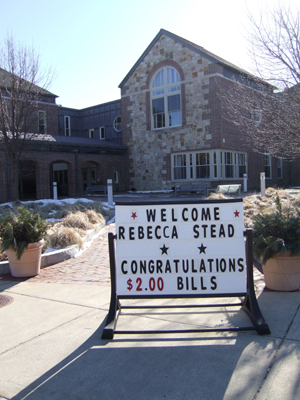
The welcome she received inside was a bit less cryptic.
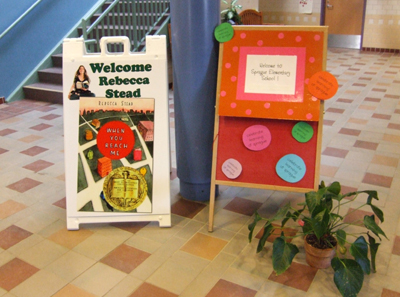
And the welcome she received from librarian Ellen Mandel needed NO deciphering! (Who doesn’t speak the language of homemade chocolate chip cookies??)
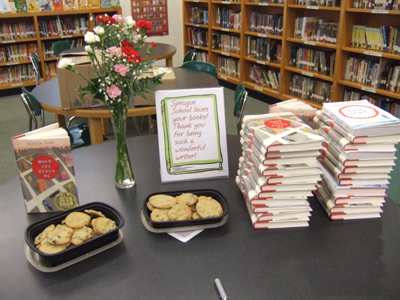
While at Sprague, Rebecca spoke to the 4th and 5th graders, all of whom had either read When You Reach Me or listened to the entire book as it was read aloud to them by their teachers. I can’t tell you how amazing it was to have a school go to such lengths to prepare their students for an author’s visit!! (Thank you, Principal Donna Dankner!) It was especially beneficial in the case of When You Reach Me, as the book contains so many secrets. On this one rare occasion, Rebecca was able to discard all worries about having to dance around possible spoilers. During this visit she could answer ANY question fully and honestly, which she did! I learned a lot of great background bits about my favorite plot points and characters at this point during the day. What a treat!
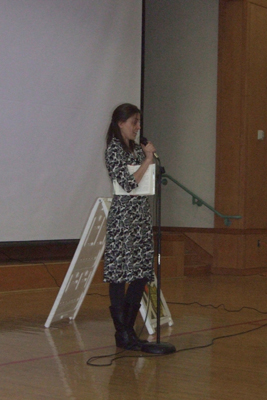
At the end of Rebecca’s presentation, she was presented with a big plastic barrel, which was the brainchild of wonderful, always enthusiastic teacher Moe Henzel. In it were notes from all of Sprague’s 4th and 5th graders. On one side of each note was the image of a $2 bill. On the other was a student’s prediction for Rebecca’s future.
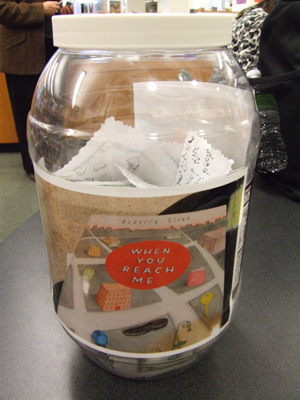
I am dying to know what things they thought she ought to be preparing herself for! Below, Rebecca shares one of the predictions with a Sprague parent who helped coordinate her visit to the school.
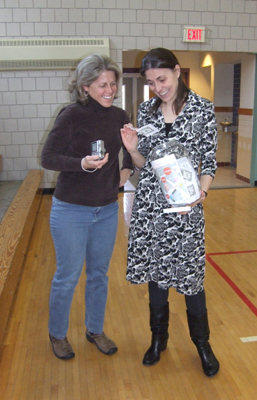
And NOW… Have you figured out why that “welcome” sign for Rebecca was so odd? The visible mention of “$2.00 Bills” was intended to be a clue. Rebecca left clues throughout her book for them — it seemed only right that they should leave clues for her too! (I love it.)
One more Sprague thing: Each year members of the outgoing 5th grade class create small paper self-portraits of themselves that one of their teachers then arranges and pastes together in group photo style to create a “class portrait” composed of individual self-portraits, like this one of the Class of 2009, below. The resulting piece is framed and hung in the school’s main stairwell, where all future classes pass by them on a daily basis, and where we passed by them on our visit too. While it’s true that it’s much harder to look at these representations years later and say, “Why that must be Susie Hackenbock! I’d know her anywhere!” these class portraits feel so much more personal and so much more lively, too — maybe because each of these kids has been able to present themselves in the way that THEY want to be seen. Interesting, no? But I digress…
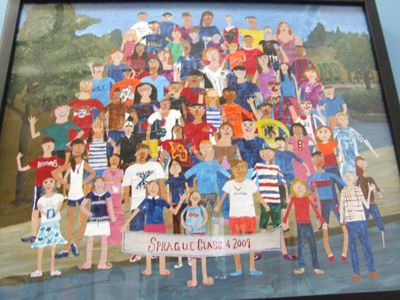
After her visit at Sprague, Rebecca joined us at the Wellesley Free Library, where she read for and took questions from an eager audience of readers, pretty evenly split between kids and adults who have enjoyed her books.
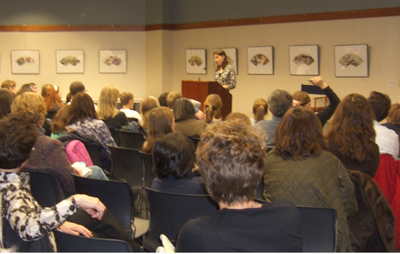
After the reading/chatting/fantastic Q&A, Rebecca signed books. Many, many books!
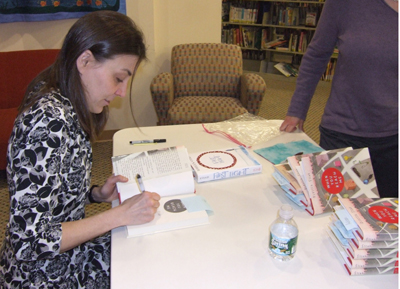
I wanted to include this photo (below) of the foamcore sign Random House sent us to promote Rebecca’s event, in part because we LOVE receiving big, splashy “put this in your store window so everyone will see this author is coming to your store” signs, and partly because I was bowled over by one little thing Random House did to “enhance” it. About a week after the ALA awards announcement, I received a slim envelope from Rebecca’s publicist that contained a scaled-to-fit-the-cover-image-on-our-sign replica of the Newbery Medal. It had CLEARLY been printed onto label paper (or some equivalent) and been cut out by hand, and while looking at it I had one of those “bless the hard-working folks in publicity” moments, thinking about how many crazy phone calls had been flowing into the Random House publicity office that week and marveling that someone cared enough to think of this one little tiny detail. Was it necessary? No. (Especially not when I’d already boldly markered the words “WINNER OF THE 2010 NEWBERY MEDAL” on the sign.) Was it nice? Yes. Very much so. AND I enjoyed finding just the right spot for that shiny gold medal to go.
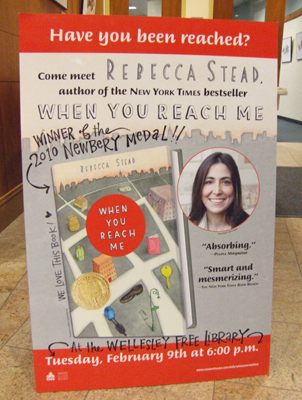
Now, here’s Rebecca, the following day, in the Tenacre Country Day School’s library. (Yes, their school library has a fireplace. Yes, we are ALL jealous of their school library!!) The kids at Tenacre asked very intelligent and personal questions about their own writing projects — things like, “What advice would you give to someone who doesn’t know how to end their story, because, well, I’m writing a book right now, and…”
I loved that Rebecca gave very sincere, honest, and encouraging answers to these questions. She didn’t belittle the importance of students’ work or dismiss their frustrations with an “Oh, you’ll get past that.” Instead, she gave them pointed pieces of advice — the same advice she’d give to adults asking her the same questions. The point at which I wanted to jump up and hug Rebecca was when she told these kids that the fact that they are struggling and trying to solve problems meant that they were truly doing the work of writers — that what they are doing is WRITING, in the truest sense of the word. It was moving for those of us adults in that room, to see these kids being treated as “equals” by a Newbery Medal-winning author, and I know the sincerity of Rebecca’s remarks made the kids value them (and her) all the more.
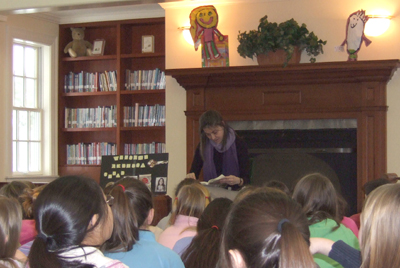
Here’s Rebecca with Tenacre’s *brilliant* School Librarian, Esther Frazee, whose creativity never ceases to amaze me. Each time I visit the school the library is filled with the most amazing projects — all of them spearheaded by her and created in the tiny amount of time in which she sees these kids each week. On the mantle behind Rebecca’s head (above) are two of the big 3D characters created by Tenacre’s kindergartners in response to Lucy Cousins’ book Yummy.
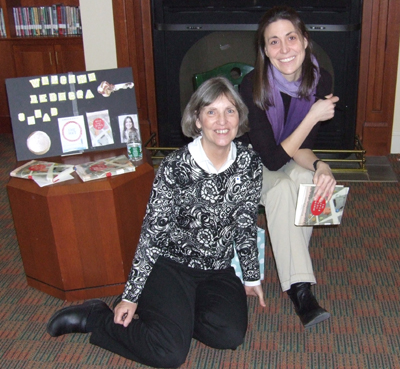
You can see more of the Yummy dolls in the photo below, AND a small “set” that was assembled in the library for Rebecca’s visit.
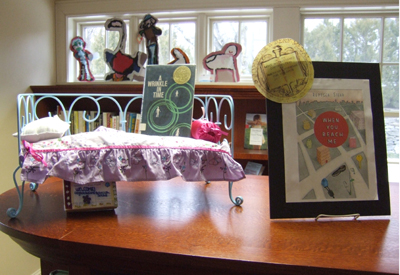
Near the bed display stood this HUGE replica of the postcard Miranda’s mother receives at the start of When You Reach Me.
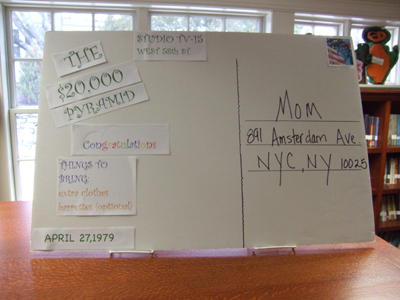
As for Rebecca’s “parting gifts” from Tenacre? Well, like the students at Sprague, this bunch each wrote individual notes to Rebecca, each one stating something the student had either LIKED or NOTICED in When You Reach Me. They gave her a Tenacre totebag filled with Tenacre branded items that they claimed to have “swiped” from the Tenacre storeroom, in the same fashion by which Miranda’s mother occasionally “swipes” things from the supply closet of the office where she works. Finally, the Tenacre group presented Rebecca with a lunch she could eat on the train back to New York: a (supposedly) “cheese, lettuce, and tomato” sandwich from (where else?) Jimmy’s. The report from Rebecca’s blog suggests that the contents of the sandwich were actually more exciting than what she’d been told to expect, and that they were quite delicious too.
Finally I can add another name to the category “Newbery Medal-Winning Authors Who Like Prosciutto.”
Favorite Childhood Books No One Else Knew (Picture Book Edition)
Elizabeth Bluemle - March 17, 2010
You know those obscure picture books you read as a child over and over again? The ones that delighted or haunted you, that stayed with you over the years, that helped form you as a person—but that no one else has ever heard of? It’s a little weird and a little cool, as though maybe ten copies were ever printed and you were the only person outside the author’s family who managed to find one. Over the years, I’ve managed to save and/or collect most of these books, and occasionally I’ll pull them down from the shelves and enjoy my Proust’s madeleine experience and go back in time.
 One of my favorite no-one-else books was Princesses’ Tresses by Luciana Roselli. This book was an early 70’s confection of (three?)-color art in sherbet hues, drawn with a fanciful, sentimental line. The story was simple, about a little girl with very short hair who yearned for long princess hair, oodles and miles and spaghetti swirls of it — until she realized how much of a pain that much hair would actually be, and she settles for trusting that her hair will grow to a pretty, manageable length and will be just fine and dandy, thank you. Why did I love this book so very much? I can’t even begin to tell you. Perhaps it was partly the fact that my mother gave it to me especially because of my very thick, impossible hair, and partly that the little girl’s name was Elisabeth (that elegant variation of my own very common name). I know it had something to do with the images that went with phrases like, ‘It would take seven handmaidens to wash it, seven suns to dry it…’ [paraphrased; I can’t find my beloved copy]. I was entranced by the improbably elaborate hairdos necessary to contain all that mass: for instance, hair parted and braided and fashioned into, say, a large garden trellis. The consequences of incredible tresses became increasingly absurd, ending, I think, with a prince or two getting lost in there. (Put Dr. Freud back on the shelf; this book was too sprightly to have engaged in metaphor.)
One of my favorite no-one-else books was Princesses’ Tresses by Luciana Roselli. This book was an early 70’s confection of (three?)-color art in sherbet hues, drawn with a fanciful, sentimental line. The story was simple, about a little girl with very short hair who yearned for long princess hair, oodles and miles and spaghetti swirls of it — until she realized how much of a pain that much hair would actually be, and she settles for trusting that her hair will grow to a pretty, manageable length and will be just fine and dandy, thank you. Why did I love this book so very much? I can’t even begin to tell you. Perhaps it was partly the fact that my mother gave it to me especially because of my very thick, impossible hair, and partly that the little girl’s name was Elisabeth (that elegant variation of my own very common name). I know it had something to do with the images that went with phrases like, ‘It would take seven handmaidens to wash it, seven suns to dry it…’ [paraphrased; I can’t find my beloved copy]. I was entranced by the improbably elaborate hairdos necessary to contain all that mass: for instance, hair parted and braided and fashioned into, say, a large garden trellis. The consequences of incredible tresses became increasingly absurd, ending, I think, with a prince or two getting lost in there. (Put Dr. Freud back on the shelf; this book was too sprightly to have engaged in metaphor.)
The writing was actually lyrical, but it was also simple and clear and comfortingly matter-of-fact, like a good fairy tale. I don’t know how and where my mother found that book, and I’m sure she never would have imagined I’d read it almost as often as I read Where the Wild Things Are, but there you are. In all my years of loving and living with books, I’ve never met another person familiar with that one.

 Minnie the Mump and Other Stories by Paul Tripp. This 1960 book about health and doctors’ visits and illnesses for kids was published by a drug company, of all things: Ross Laboratories in Columbus, Ohio. Its full title, in fact, is preceded by “The Vi_Daylin® book of….” Turns out that Vi-Daylin® was “the Ross Laboratories brand of vitamin supplement.” What I loved about this book were the illustrations: personified illnesses like CLARA the COLD, CHARLIE CHICKEN POX, HERMAN GERMAN MEASLES, MOLLY MEASLES, SCARLET FEVER (“She is a STREPTOCOCCUS which is not a nice thing to be”). They were suitably nasty creatures, but in a friendly sort of way — not an easy duality to carry off. Do you know it wasn’t until I pulled this one from the shelf tonight that I realized the artist was Trina Hyman (no Schart back then)?! No wonder I loved the illustrations!
Minnie the Mump and Other Stories by Paul Tripp. This 1960 book about health and doctors’ visits and illnesses for kids was published by a drug company, of all things: Ross Laboratories in Columbus, Ohio. Its full title, in fact, is preceded by “The Vi_Daylin® book of….” Turns out that Vi-Daylin® was “the Ross Laboratories brand of vitamin supplement.” What I loved about this book were the illustrations: personified illnesses like CLARA the COLD, CHARLIE CHICKEN POX, HERMAN GERMAN MEASLES, MOLLY MEASLES, SCARLET FEVER (“She is a STREPTOCOCCUS which is not a nice thing to be”). They were suitably nasty creatures, but in a friendly sort of way — not an easy duality to carry off. Do you know it wasn’t until I pulled this one from the shelf tonight that I realized the artist was Trina Hyman (no Schart back then)?! No wonder I loved the illustrations!


 I’ve always loved miniature things, so when my mother brought home a book featuring a tiny tiger nestled in flowers, I was enchanted. Tiger Flower, “a tale by Robert Vavra around paintings by Fleur Cowles with a preface by Yehudi Menuhin,” was an odd book that didn’t tell a story so much as present a lot of lovely paintings of a topsy-turvy natural world where mushrooms were the size of trees and lions and tigers balanced on blades of grass, no longer hunting zebras but, rather, flowers for bouquets. I’ve never met anyone else who encountered it as a child, and in fact, it’s the kind of arty, slightly distant book that perhaps has more adult than child appeal. (I’ll bet my mom found it at an art gallery or museum in Phoenix somewhere.) Still, though I didn’t connect strongly to the words, the idea of a miniature tiger—a tiger small enough to run around in the palm of my hand, or to be blanketed by a rose petal—brought me back again and again to the pages of that book.
I’ve always loved miniature things, so when my mother brought home a book featuring a tiny tiger nestled in flowers, I was enchanted. Tiger Flower, “a tale by Robert Vavra around paintings by Fleur Cowles with a preface by Yehudi Menuhin,” was an odd book that didn’t tell a story so much as present a lot of lovely paintings of a topsy-turvy natural world where mushrooms were the size of trees and lions and tigers balanced on blades of grass, no longer hunting zebras but, rather, flowers for bouquets. I’ve never met anyone else who encountered it as a child, and in fact, it’s the kind of arty, slightly distant book that perhaps has more adult than child appeal. (I’ll bet my mom found it at an art gallery or museum in Phoenix somewhere.) Still, though I didn’t connect strongly to the words, the idea of a miniature tiger—a tiger small enough to run around in the palm of my hand, or to be blanketed by a rose petal—brought me back again and again to the pages of that book.

Arm in Arm by Remy Charlip might have been written just for me: a child who got lost in funny words and skewed ideas and pictures that asked questions. An unorthodox picture book, it was a collection of jokes and wordplay and skits and mini-stories poetry and very-1970s doodly playful rainbow-colored illustrations and hand-lettered text that spiraled around in shapes to follow along the page.  The subtitle alone was delicious: A Collection of Connections, Endless Tales, Reiterations, and Other Echolalia. (Try getting THAT past Acquisitions today.) It was the very essence of imaginative art, full of funny little touches and bright spirit. It even sneaked in some philosophy. I can’t tell you the number of hours I spent inside this book, pondering the concepts and poring over the art, the fine lines and miniature drawings and bursts of color. Incidentally, Arm in Arm also gave me my favorite childhood joke: “Ask me if I’m a boat.” “Are you a boat?” “Yes. Now ask me if I’m an airplane.” “Are you an airplane?” “No, silly, I’m a boat.” I still have my old copy, inscribed by my mom in 1973: “…a silly fun book because you are fun to be silly with.” (Inscriptions are practically a lost art, and I miss them.) Although Remy Charlip wasn’t and isn’t an obscure author, I was the only kid I knew who had that book. It was unique in format and freedom, and it was a touchstone for me.
The subtitle alone was delicious: A Collection of Connections, Endless Tales, Reiterations, and Other Echolalia. (Try getting THAT past Acquisitions today.) It was the very essence of imaginative art, full of funny little touches and bright spirit. It even sneaked in some philosophy. I can’t tell you the number of hours I spent inside this book, pondering the concepts and poring over the art, the fine lines and miniature drawings and bursts of color. Incidentally, Arm in Arm also gave me my favorite childhood joke: “Ask me if I’m a boat.” “Are you a boat?” “Yes. Now ask me if I’m an airplane.” “Are you an airplane?” “No, silly, I’m a boat.” I still have my old copy, inscribed by my mom in 1973: “…a silly fun book because you are fun to be silly with.” (Inscriptions are practically a lost art, and I miss them.) Although Remy Charlip wasn’t and isn’t an obscure author, I was the only kid I knew who had that book. It was unique in format and freedom, and it was a touchstone for me.
 Another no-one-else picture book was The Magic Friend Maker by Gladys Baker Bond, illustrated by Stina Nagel. It’s the story of Beth, a shy “one-girl,”an only child with no best friend. Then she meets Jean, a new girl in the neighborhood who befriends Beth by showing her a special, egg-sized rock. I loved that rock and its mysterious colors: “It looked very old. Its brownness was streaked with one color that looked like rust on old iron, and another color that looked like a policeman’s coat on a smoggy morning.” It turns wonderful colors when submerged in water, “… like melted candy, streaked with red, yellow, and shadowy blue.” Brought together by the stone, two girls become best best best best friends.
Another no-one-else picture book was The Magic Friend Maker by Gladys Baker Bond, illustrated by Stina Nagel. It’s the story of Beth, a shy “one-girl,”an only child with no best friend. Then she meets Jean, a new girl in the neighborhood who befriends Beth by showing her a special, egg-sized rock. I loved that rock and its mysterious colors: “It looked very old. Its brownness was streaked with one color that looked like rust on old iron, and another color that looked like a policeman’s coat on a smoggy morning.” It turns wonderful colors when submerged in water, “… like melted candy, streaked with red, yellow, and shadowy blue.” Brought together by the stone, two girls become best best best best friends.  But all good things must come to an end, and one day, Jean announces she has to move. Beth is despondent, but then a new girl moves in, and Beth — I know this will shock you — befriends her with the rock Jean gave to Beth as she was leaving. “It was just a rock until it was shared. Then it became a magic friend-maker.” I don’t know why I liked this simple story so much. I wasn’t a “one-girl;” I had a sibling and little friends to play with. But man, I loved that rock. I still gather a stone or two when visiting a new place, or going back to an old one, and I know that my habit of rinsing stones to see what they look like wet is due to The Magic Friend Maker.
But all good things must come to an end, and one day, Jean announces she has to move. Beth is despondent, but then a new girl moves in, and Beth — I know this will shock you — befriends her with the rock Jean gave to Beth as she was leaving. “It was just a rock until it was shared. Then it became a magic friend-maker.” I don’t know why I liked this simple story so much. I wasn’t a “one-girl;” I had a sibling and little friends to play with. But man, I loved that rock. I still gather a stone or two when visiting a new place, or going back to an old one, and I know that my habit of rinsing stones to see what they look like wet is due to The Magic Friend Maker.
 Recently, my entire understanding of this book was called into question by a friend who facetiously found a wildly lesbian subtext in the friendship; she quoted lines like “Touch it …. My rock gets warm when you hold it,” with an exaggerated leer, making me both laugh hysterically and hate her a teeny bit for forever besmirching my inner five-year-old’s delight at the friendly faces, innocent hand-holding, and happy teeter-totters, wild swings, and cute sparrows in the park. “Want to touch my rock?” It’ll never be the same.
Recently, my entire understanding of this book was called into question by a friend who facetiously found a wildly lesbian subtext in the friendship; she quoted lines like “Touch it …. My rock gets warm when you hold it,” with an exaggerated leer, making me both laugh hysterically and hate her a teeny bit for forever besmirching my inner five-year-old’s delight at the friendly faces, innocent hand-holding, and happy teeter-totters, wild swings, and cute sparrows in the park. “Want to touch my rock?” It’ll never be the same.
This is why perhaps some of these no-one-else books deserve their place in solo memory, so you can keep your rocks rocks and your cigars cigars. But in case you want to share, I’m really curious: what are YOUR no-one-else books?
